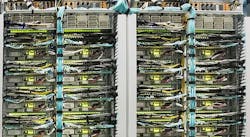The network is the new focus in the cloud computing wars. Google today introduced network tiers, providing Google Cloud Platform (GCP) customers with the option to save money by having some traffic delivered over the Internet, rather than Google’s private network.
The new service allows customers to assign workloads to different network tiers based on their performance requirements, keeping priority applications on Google’s network while using the Internet to deliver workloads that don’t need a low-latency connection. This kind of tiered segmentation of workloads has been used as a cost management strategy in data storage for many years.
Google says that GCP customers in North America and Europe can save 24 to 33 percent on their GCP traffic costs by using the new Standard Tier instead of the existing service using Google’s network, which is now known as Premium Tier. Standard Tier delivers outbound traffic from GCP to the internet over transit (ISP) networks where it may experience congestion or outages more frequently relative to Premium Tier, but at a level comparable to other major public clouds, Google said.
Leading With Its Network
It’s the latest in a series of move by Google to boost the competitive position of Google Cloud Platform in the high-stakes battle for cloud dominance. Several recent announcements have focused on moving data across the networking, which is a growing concern for enterprises and Internet businesses amid an explosion of data as IT capacity shifts to cloud platforms.
It’s a trend that’s likely to accelerate with the adoption of next-generation technologies including 5G wireless, autonomous vehicles, virtual reality, the Internet of Things and edge computing, with some computing workloads shifting to mobile devices.
Last month the company unveiled Google Transfer Appliance, which can be used to physically transfer large volumes of data to the GCP cloud platform. It also boosted GCP with a cutting-edge algorithm to reduce network congestion, which should offer improved application and web site performance for customers.
In seeking to differentiate its cloud, Google is leveraging its reputation for fast response time.
“Over the last 18 years, we built the world’s largest network, which by some accounts delivers 25-30% of all internet traffic” said Urs Hölzle, SVP Technical Infrastructure, Google. “You enjoy the same infrastructure with Premium Tier. But for some use cases, you may prefer a cheaper, lower-performance alternative. With Network Service Tiers, you can choose the network that’s right for you, for each application.”
Here’s a look at the difference in how data travels across the two network tiers:
The ability to shift workloads to a less expensive network may prove attractive to customers focused on optimizing the cost of their cloud usage.
“Cloud customers want choices in service levels and cost,” said Dan Conde, Analyst at ESG. “Matching the right service to the right business requirements provides the alignment needed by customers,” “Google is the first public cloud provider to recognize that in the alpha release of Network Service Tiers. Premium Tier caters to those who need assured quality, and Standard Tier to those who need lower costs or have limited need for global networking.”
About the Author



